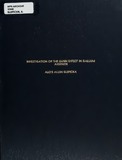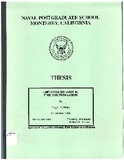Investigation of the Gunn effect in gallium arsenide
| dc.contributor.advisor | Sackman, George L. | |
| dc.contributor.author | Slepicka, Alois Allen | |
| dc.date.accessioned | 2012-08-09T19:32:14Z | |
| dc.date.available | 2012-08-09T19:32:14Z | |
| dc.date.issued | 1966-05 | |
| dc.identifier.uri | https://hdl.handle.net/10945/9551 | |
| dc.description.abstract | When the electric field in certain compound semiconductors exceeds a well-defined threshold value, the electrical current through the material becomes unstable. These instabilities may take the form of coherent Oscillations at microwave frequencies. The oscillations are not greatly affected by external circuit conditions. The effect was first discovered in gallium arsenide and indium phosphide by J. B. Gunn in 1963, and is now referred to as the "Gunn effect".This paper discusses some of the practical aspects of the Gunn effect in gallium arsenide. A brief theoretical explanation is given, of the intervalley electron energy transfer mechanism which is now generally accepted as the mechanism through which the effect occurs. The preparation of samples is described, and the nature of the electrical contacts to the material discussed. Ohmic contacts are necessary to prevent junction effects or carrier injection from masking the oscillations. Mounting techniques are described. Circuit considerations are discussed, and the results of various measurements reported. The value of the Gunn effect lies in its potential to directly convert pulse or DC power into microwave power, at frequencies and power levels higher than is possible with other semiconductor devices, and at reasonable efficiencies. | en_US |
| dc.description.uri | http://archive.org/details/investigationofg109459551 | |
| dc.language.iso | en_US | |
| dc.publisher | Monterey, California. U.S. Naval Postgraduate School | en_US |
| dc.rights | This publication is a work of the U.S. Government as defined in Title 17, United States Code, Section 101. Copyright protection is not available for this work in the United States. | en_US |
| dc.subject.lcsh | Electronics | en_US |
| dc.title | Investigation of the Gunn effect in gallium arsenide | en_US |
| dc.type | Thesis | en_US |
| dc.description.service | Major, United States Marine Corps | en_US |
| etd.thesisdegree.name | M.S. in Engineering Electronics | en_US |
| etd.thesisdegree.level | Masters | en_US |
| etd.thesisdegree.discipline | Engineering Electronics | en_US |
| etd.thesisdegree.grantor | Naval Postgraduate School | en_US |
Files in this item
This item appears in the following Collection(s)
-
1. Thesis and Dissertation Collection, all items
Publicly releasable NPS Theses, Dissertations, MBA Professional Reports, Joint Applied Projects, Systems Engineering Project Reports and other NPS degree-earning written works.





